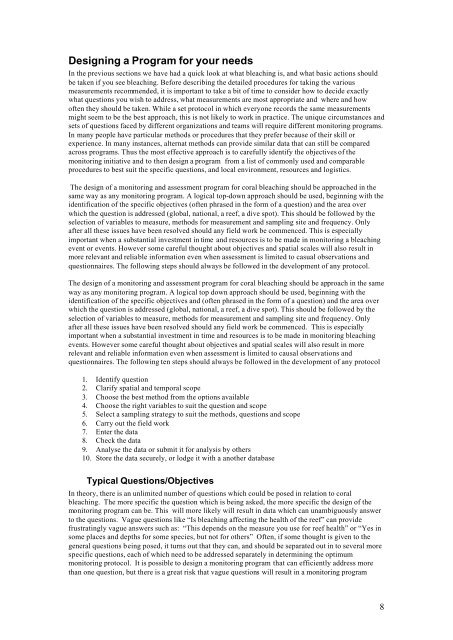Oliver et al (2004) Monitoring bleaching
Oliver et al (2004) Monitoring bleaching.pdf
Oliver et al (2004) Monitoring bleaching.pdf
Create successful ePaper yourself
Turn your PDF publications into a flip-book with our unique Google optimized e-Paper software.
Designing a Program for your needs<br />
In the previous sections we have had a quick look at what <strong>bleaching</strong> is, and what basic actions should<br />
be taken if you see <strong>bleaching</strong>. Before describing the d<strong>et</strong>ailed procedures for taking the various<br />
measurements recommended, it is important to take a bit of time to consider how to decide exactly<br />
what questions you wish to address, what measurements are most appropriate and where and how<br />
often they should be taken. While a s<strong>et</strong> protocol in which everyone records the same measurements<br />
might seem to be the best approach, this is not likely to work in practice. The unique circumstances and<br />
s<strong>et</strong>s of questions faced by different organizations and teams will require different monitoring programs.<br />
In many people have particular m<strong>et</strong>hods or procedures that they prefer because of their skill or<br />
experience. In many instances, <strong>al</strong>ternat m<strong>et</strong>hods can provide similar data that can still be compared<br />
across programs. Thus the most effective approach is to carefully identify the objectives of the<br />
monitoring initiative and to then design a program from a list of commonly used and comparable<br />
procedures to best suit the specific questions, and loc<strong>al</strong> environment, resources and logistics.<br />
The design of a monitoring and assessment program for cor<strong>al</strong> <strong>bleaching</strong> should be approached in the<br />
same way as any monitoring program. A logic<strong>al</strong> top-down approach should be used, beginning with the<br />
identification of the specific objectives (often phrased in the form of a question) and the area over<br />
which the question is addressed (glob<strong>al</strong>, nation<strong>al</strong>, a reef, a dive spot). This should be followed by the<br />
selection of variables to measure, m<strong>et</strong>hods for measurement and sampling site and frequency. Only<br />
after <strong>al</strong>l these issues have been resolved should any field work be commenced. This is especi<strong>al</strong>ly<br />
important when a substanti<strong>al</strong> investment in time and resources is to be made in monitoring a <strong>bleaching</strong><br />
event or events. However some careful thought about objectives and spati<strong>al</strong> sc<strong>al</strong>es will <strong>al</strong>so result in<br />
more relevant and reliable information even when assessment is limited to casu<strong>al</strong> observations and<br />
questionnaires. The following steps should <strong>al</strong>ways be followed in the development of any protocol.<br />
The design of a monitoring and assessment program for cor<strong>al</strong> <strong>bleaching</strong> should be approach in the same<br />
way as any monitoring program. A logic<strong>al</strong> top down approach should be used, beginning with the<br />
identification of the specific objectives and (often phrased in the form of a question) and the area over<br />
which the question is addressed (glob<strong>al</strong>, nation<strong>al</strong>, a reef, a dive spot). This should be followed by the<br />
selection of variables to measure, m<strong>et</strong>hods for measurement and sampling site and frequency. Only<br />
after <strong>al</strong>l these issues have been resolved should any field work be commenced. This is especi<strong>al</strong>ly<br />
important when a substanti<strong>al</strong> investment in time and resources is to be made in monitoring <strong>bleaching</strong><br />
events. However some careful thought about objectives and spati<strong>al</strong> sc<strong>al</strong>es will <strong>al</strong>so result in more<br />
relevant and reliable information even when assessment is limited to caus<strong>al</strong> observations and<br />
questionnaires. The following ten steps should <strong>al</strong>ways be followed in the development of any protocol<br />
1. Identify question<br />
2. Clarify spati<strong>al</strong> and tempor<strong>al</strong> scope<br />
3. Choose the best m<strong>et</strong>hod from the options available<br />
4. Choose the right variables to suit the question and scope<br />
5. Select a sampling strategy to suit the m<strong>et</strong>hods, questions and scope<br />
6. Carry out the field work<br />
7. Enter the data<br />
8. Check the data<br />
9. An<strong>al</strong>yse the data or submit it for an<strong>al</strong>ysis by others<br />
10. Store the data securely, or lodge it with a another database<br />
Typic<strong>al</strong> Questions/Objectives<br />
In theory, there is an unlimited number of questions which could be posed in relation to cor<strong>al</strong><br />
<strong>bleaching</strong>. The more specific the question which is being asked, the more specific the design of the<br />
monitoring program can be. This will more likely will result in data which can unambiguously answer<br />
to the questions. Vague questions like “Is <strong>bleaching</strong> affecting the he<strong>al</strong>th of the reef” can provide<br />
frustratingly vague answers such as: “This depends on the measure you use for reef he<strong>al</strong>th” or “Yes in<br />
some places and depths for some species, but not for others” Often, if some thought is given to the<br />
gener<strong>al</strong> questions being posed, it turns out that they can, and should be separated out in to sever<strong>al</strong> more<br />
specific questions, each of which need to be addressed separately in d<strong>et</strong>ermining the optimum<br />
monitoring protocol. It is possible to design a monitoring program that can efficiently address more<br />
than one question, but there is a great risk that vague questions will result in a monitoring program<br />
8


















